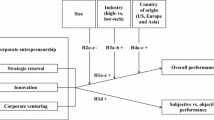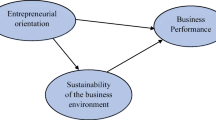Abstract
It is widely acknowledged that guanxi constitutes a key strategic factor affecting firm performance in the greater China area. However, very little empirical research on the issue has been done in the literature. In this study we explore the systematic linkage between guanxi and firm performance from a business strategy perspective. The evidence shows that guanxi-based business variables have a profound and positive impact on firm efficiency and growth.
Similar content being viewed by others
REFERENCES
Alston, J. P. 1989. Wa, Guanxi, and Inhwa: managerial principles in Japan, China, and Korea. Business Horizons, March–April: 26–31.
Andersson, P. 1992. Analyzing distribution channel dynamics: loose and tight coupling in distribution networks, European Journal of Marketing, 26, 47–68.
Beamish, P. M. and Banks, J. C. 1987. Equity joint ventures and the theory of the multinational enterprises, Journal of International Business Studies, Summer: 1–16.
Buckley, P. and Casson, M. 1988. The theory of cooperation in international business, In Farok Contractor & Peter Lorange (eds), Cooperative Strategies in International Business, pp. 31–34, Lexington, Mass.: Lexington Books.
Butterfield, F. 1982. China: Alive in the Bitter Sea. New York: Times Books.
Campbell, N. 1987. Experiences of Western companies in China, Euro-Asia Business Review, July: 35–38.
Chauvin, K. W. and Hirschey, M. 1993. Advertising, R&D expenditures and the market value of the firm, Financial Management, 22(4): 128–140.
Chen, M. 1994. Guanxi and the Chinese art of network building, New Asia Review, Summer: 40–43.
Copeland, L. and Griggs, L. 1985. Going International, New York: Random House.
Davidson, W. H. and McFetridge, D. G. 1985. Key characteristics in the choice of international technology transfer mode, Journal of International Business Studies, Summer: 5–21.
Gallego, G. and VanRyzin, G. 1994. Optimal dynamics pricing of inventories with stochastic demand over finite horizons, Management Science, 40: 999–1020.
Geringer, J. M. and Hebert, L. 1991. Measuring performance of international joint ventures, Journal of International Business Studies, second quarter: 249–264.
Hair, J. F., Anderson, R. E., Tatham, R. L. and Black, W. C. 1992. Multivariate Data Analysis, 3rd edition. Macmillan Publishing Company.
Hall, M. and Weiss, L. 1967. Firm size and profitability, The Review of Economics and Statistics, 49: 319–331.
Harrigan, K. P. 1985. Strategies for Joint Ventures, Lexington, Mass.: D.C. Health.
Hoskisson, K. O. and Johnson, R. A. 1992. Corporate restructuring and strategic change: the effect on diversification strategy and R&D intensity, Strategic Management Journal, 9(2): 141–158.
Hwang, E.R. 1987. Face and favor: the Chinese power game, American Journal of Sociology, 92(4), 35–41.
Kakansson, H. and Snehota, I. 1990. No business is an island: the network concept of business strategy. In Industrial Networks: A New View of Reality, Axelsson & Easton (eds), pp. 526–540. Academic Press.
Kao, J. 1993. The worldwide web of Chinese business, Harvard Business Review, March–April: 24–36.
Luo, Y. 1995. Business strategy, market structure, and performance of international joint ventures: the case of joint ventures in China, Management International Review, 35(3), 241–264.
News Bulletin, 1995. Ministry of Foreign Trade and Economic Cooperation (MOFTEC), P. R. China, 1995: issue no. 1 and 2.
Peng, M. W. 1995. The China strategy: a tale of two firms, In C.W.L. Hill & G.R. Jones (eds), Strategic Management: An Integrated Approach, 3rd edition, pp. 519–532. Boston: Houghton Mifflin.
Pollock, M. M. 1991. All the right connections, Asian Business, January: 20–24.
Punnett, B. J. and Yu, P. 1990. Attitudes toward doing business with the PRC, International Studies of Management and Organization, 20(1): 149–60.
Redding, S. G. and Ng, M. 1982. The role of ‘face’ in the organizational perceptions of chinese managers, Organizational Studies, 3(3): 204–209.
SAS/STAT User's Guide. 1990. SAS Institute Inc., Version 6, Fourth edition, Cary, NC: SAS Institute.
Shenkar, O. 1990. International joint ventures' problems in China: risks and remedies, Long Range Planning, 23(3), 82–90.
Tai, L. S. T. 1988. Doing business in the People's Republic of China: some keys to success, Management International Review, 28(1): 5–9.
Thorelli, H. B. 1986. Networks: between markets and hierarchies, Strategic Management Journal, 7: 37–51.
Wall, J. A. 1990. Managers in the People's Republic of China, Academy of Management Executive, 4(2), 19–32.
Xin, K. and Pearce, J. L. 1994. Guanxi: good connections as substitutes for institutional support, Paper presented at the annual meeting of the Academy of Management, Dallas.
Author information
Authors and Affiliations
Rights and permissions
About this article
Cite this article
Luo, Y., Chen, M. Does Guanxi Influence Firm Performance?. Asia Pacific Journal of Management 14, 1–16 (1997). https://doi.org/10.1023/A:1015401928005
Issue Date:
DOI: https://doi.org/10.1023/A:1015401928005




